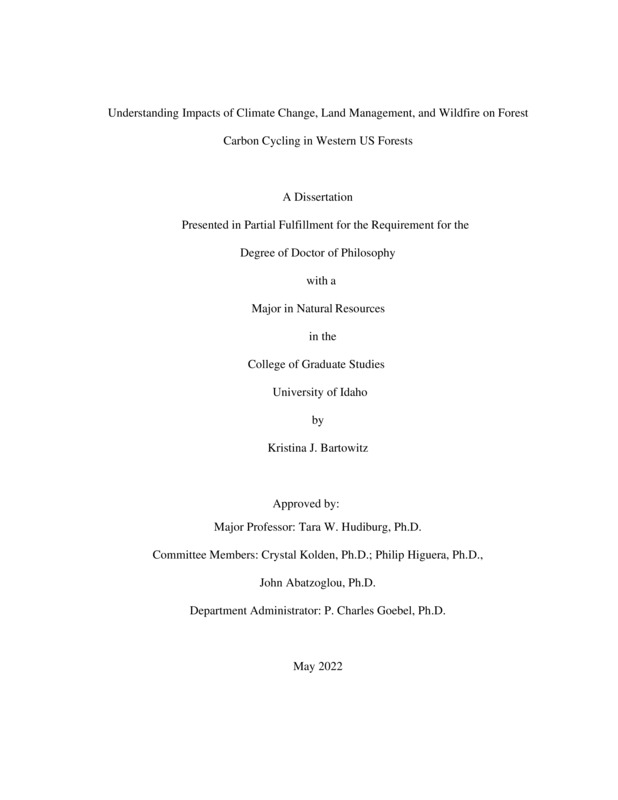Understanding impacts of climate change, land management, and wildfire on forest carbon cycling in western US forests
Bartowitz, Kristina. (2022-05). Understanding impacts of climate change, land management, and wildfire on forest carbon cycling in western US forests. Theses and Dissertations Collection, University of Idaho Library Digital Collections. https://www.lib.uidaho.edu/digital/etd/items/bartowitz_idaho_0089e_12277.html
- Title:
- Understanding impacts of climate change, land management, and wildfire on forest carbon cycling in western US forests
- Author:
- Bartowitz, Kristina
- ORCID:
- 0000-0002-9488-8930
- Date:
- 2022-05
- Embargo Remove Date:
- 2023-05-25
- Program:
- Forest, Rangeland & Fire Sci
- Subject Category:
- Ecology
- Abstract:
-
Forests play a critical role in climate regulation through their ability to both store a large amount of long-term and persistent terrestrial carbon, and continually sequester carbon from the atmosphere. In addition to carbon storage and sequestration, western US forests provide vital ecosystem services such as wood products, wildlife habitat, recreation, and erosion control. The interactive effects of climate change, land management, and wildfire regimes influence the sustainability of forest growth and stability, biodiversity, and water availability Human and ecological disturbances such as climate change, wildfires, and forest management can significantly decrease forest carbon stocks and sequestration. There is a critical need to better understand and accurately predict the nature and severity of the interactive effects to guide forest management and policy decisions aimed at forest resilience and climate mitigation. This dissertation addresses the uncertainty associated with impacts of forest disturbances (wildfires and forest management) and climate change on forest carbon dynamics, using data synthesis and ecosystem models. I use publicly available datasets to evaluate how past wildfires and forest management have influenced current forests and use ecosystem models to predict how climate change and future fires will impact forests across space and time. Improved mechanistic predictions of forest conditions will be key to developing relevant management plans at local and regional scales. Here, I clarify the impacts of climate change, wildfires, and land management on forest carbon dynamics across paleo timescales (Chapter 1), the modern historical records (Chapter 2), and the simulated future (Chapter 3). In Chapter 1, I explored the interactions between fire and carbon dynamics of 14 subalpine forested watersheds in Colorado, USA across 2000 years. Through a modeling experiment, I tested the impact of varying fire frequency over a ~2000 year period on ecosystem productivity and carbon storage using an improved biogeochemical model (Snagged DayCent). The experiment included high-fire, paleo-record fire, and no fire scenarios. High fire frequency simulations had overall lower carbon stocks across all sites compared to scenarios with the paleo-record or no fire frequency scenarios, highlighting the importance of fire frequency and fire timing variability in determining ecosystem carbon storage. In Chapter 2, I investigated differences in western US forest fire carbon emissions, restoration (understory and small-diameter tree removal, and prescribed burns) and extractive forest management (harvest for timber sale), and fossil fuel emissions over the past decade. Forest fire carbon emissions are on average only 6% of anthropogenic fossil fuel emissions over. Restoration thinning and commercial harvest of mature trees releases a higher density of carbon emissions relative to wildfire (200-1300%). These results show that extractive forest management increases emissions rather than preventing them and suggest that reducing fossil fuel emissions will do more for climate mitigation potential, and subsequent reduction of fire, than increasing extractive harvest to prevent fire emissions. This chapter also discusses policy and management choices to lead to both more resilient forests, and better climate mitigation strategies. Management aimed at fuels reduction to moderate fire behavior and increase forest resilience (such as restoration thinning and prescribed burns) will help to balance reducing catastrophic fire near communities and leave live mature trees on the landscape to continue carbon uptake. In Chapter 3, I modeled future fire occurrence and carbon dynamics in Northern Rocky forests. Despite the lack of wildfire in some these forests over the last century, it is unclear how fire occurrence and carbon dynamics in these forests will look in the future with continued warming and drying, and how future fire and future climate may impact the carbon balance of the region. I explore the climate-fire-ecosystem interactions in the Northern Rockies through ecosystem modeling. Here, we use an Earth Systems Model with dynamic vegetation (CLM-FATES) and fire module (SPITFIRE) to investigate the future of fire and carbon dynamics in the Northern Rockies over the next century. Future simulations (until 2080) forced with future climate data show an increase in wildfire from the modern record for the wet and cold forest types, while the warm-dry forest type continues to have a shorter mean fire return interval (15-25 years). Fire occurrence in the wet and cold forests is followed by immediate, subsequent decreases in forest carbon (up to 20% loss). However, post-fire recovery of forest carbon stocks occurs for all forest types for the simulation range, with complete AGC recovery seen in as little as 10-20 years following some of the disturbances.
- Description:
- doctoral, Ph.D., Forest, Rangeland & Fire Sci -- University of Idaho - College of Graduate Studies, 2022-05
- Major Professor:
- Hudiburg, Tara W
- Committee:
- Kolden, Crystal; Abatzoglou, John; Higuera, Philip; Goebel, P. Charles
- Defense Date:
- 2022-05
- Identifier:
- Bartowitz_idaho_0089E_12277
- Type:
- Text
- Format Original:
- Format:
- application/pdf
- Rights:
- In Copyright - Educational Use Permitted. For more information, please contact University of Idaho Library Special Collections and Archives Department at libspec@uidaho.edu.
- Standardized Rights:
- http://rightsstatements.org/vocab/InC-EDU/1.0/

